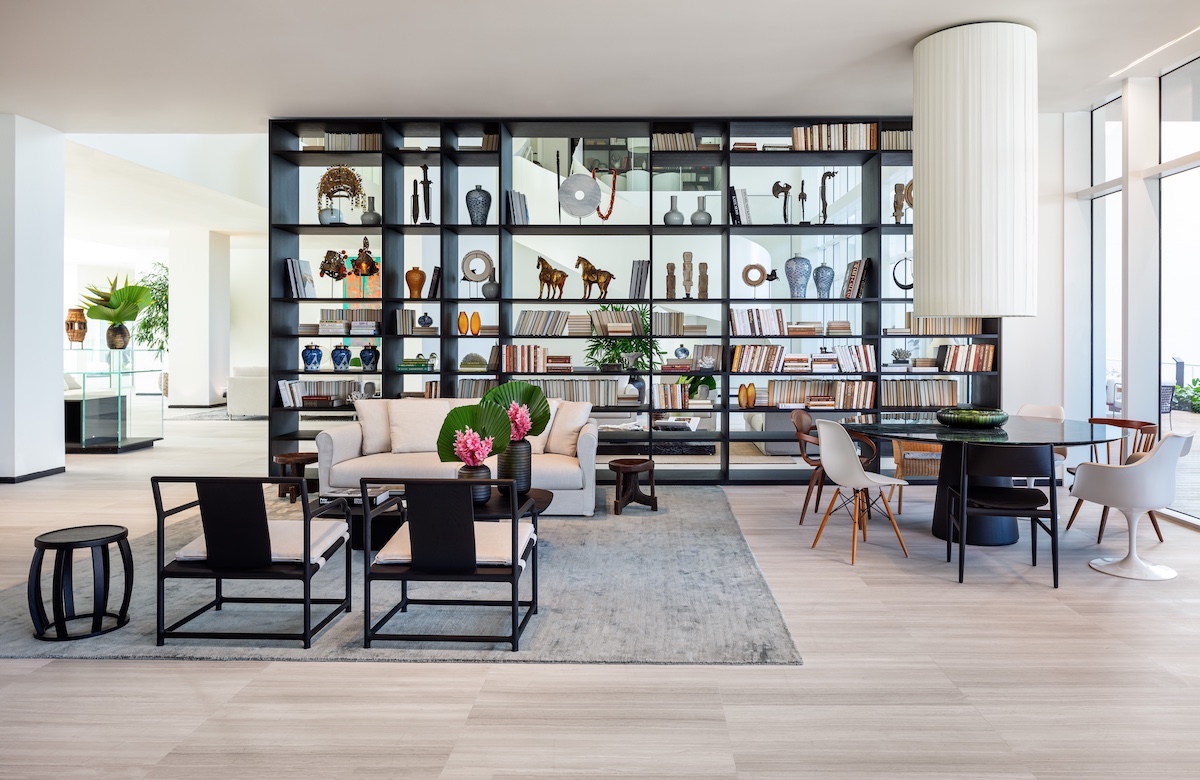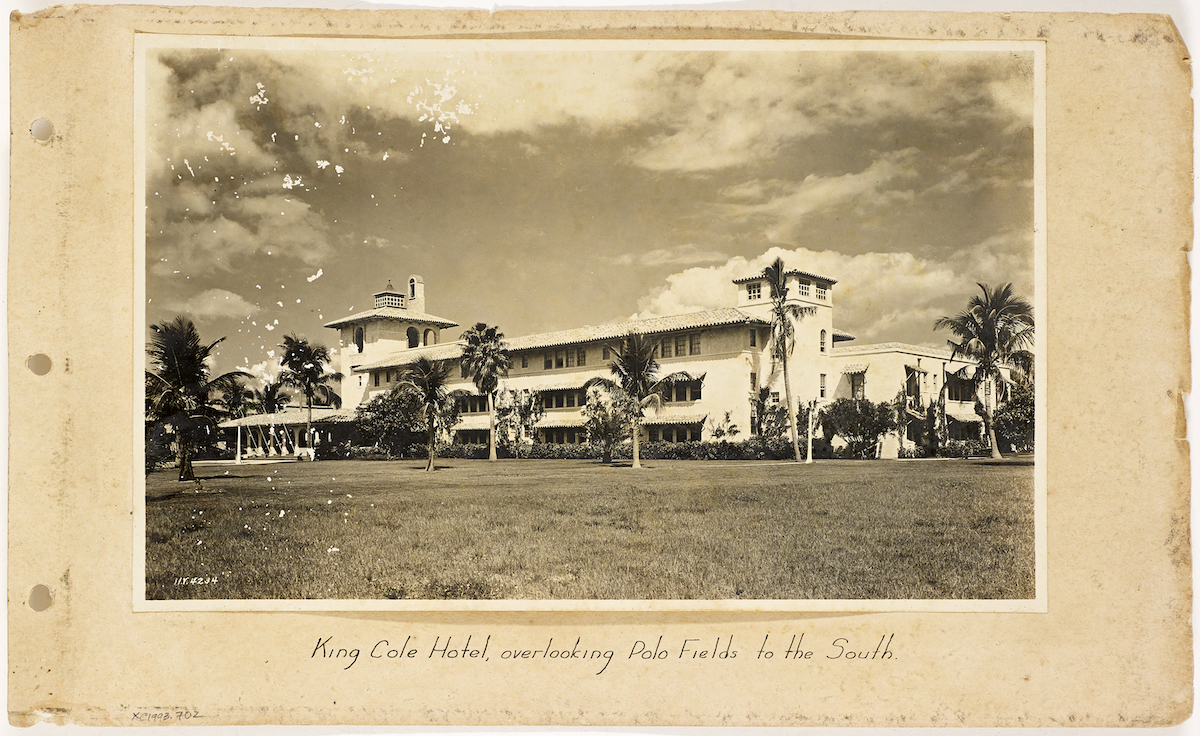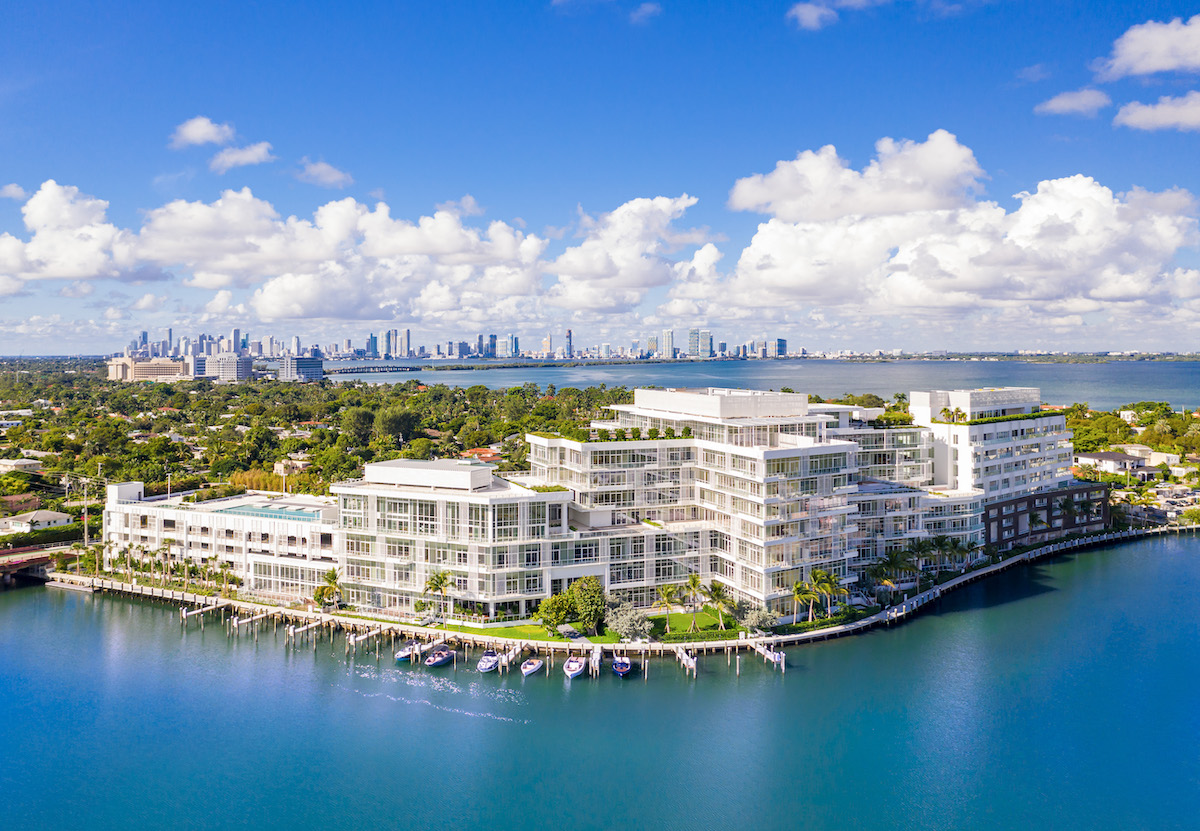In the 1920s, the King Cole Hotel helped put Miami Beach on the map as a popular tourist destination. Automotive industry pioneer and entrepreneur Carl Fisher developed the three-story, 60-room hotel to fulfill his vision of turning vacant land into an oceanfront winter getaway.
The hotel, which functioned as a military hospital during World War II, faced the wrecking ball in 1965 to make way for the property’s next occupant: the Miami Heart Institute. Over the next three decades, the hospital expanded its footprint on the 7.2-acre site to encompass six structures.
In 2000, Mount Sinai Medical Center acquired the Miami Heart Institute and ultimately consolidated its operations at the competing hospital system’s main campus about a mile away.
Real estate investment and development firm Lionheart Capital stepped in to purchase the deserted complex for $20 million in 2012, initiating the property’s third act as a luxury condo development. “It was a fair price, in an excellent location, and we felt confident we could transform the property into something truly special,” said Allison Greenfield, Partner at Lionheart Capital.

Residents have 24-hour access to a private art studio equipped with easels, sculpting surfaces, reference books, and supplies. Photo: Kim Sargent
But Lionheart faced some tough obstacles in converting the former hospital into condos—and starting from scratch wasn’t an option. “The site was overbuilt by about 600,000 square feet, so we would lose that space if we demolished the buildings,” said Greenfield. Rezoning the property to residential use would also limit the maximum building height of new construction to four stories.
Lionheart enlisted Stantec’s Miami practice to oversee the conversion process as architect of record. “The city was eager to approve the zoning change as long as the neighbors were in favor of it,” said Christina Villa, Senior Associate in Stantec’s Miami office.
ALSO SEE: Historic ‘skyscraper hospital’ in Brooklyn refashioned into 17 luxury condominium residences
Stantec staff met with residents of the surrounding Mid-Beach neighborhood, composed of single-family homes that range from historic 1920s structures to modern residences. “Most of the neighbors were ecstatic to hear that we were planning a condo development because it would decrease traffic and be more compatible with the neighborhood,” said Villa.
The intricate planning and design process involved reconfiguring the existing institutional building layouts to accommodate high-end residential units. “We stripped away everything that made the complex look like a hospital and brought it down to its bare columns, then started to carve out the massing of the buildings to make the floor plates work,” said Villa.
The process yielded a staggering 64 different unit layouts. “Unlike a typical South Florida multifamily building, where buyers choose a view and a stock layout, we essentially created 64 vertically stacked single-family homes,” said Greenfield.

The club room at the Ritz-Carlton Residences. Residents have access to the services of the Agatston Center for Private Medicine, led by Arthur Agatston, the cardiologist who created the South Beach Diet. Photo: Kim Sargent
Because the slabs between adjoining buildings did not align, the Stantec team planned each unit within the floor plates of its original structure, then created several new elevator lobbies that would transport residents directly up to their units.
The lower levels of the former hospital featured floor-to-floor heights of 12 to 14 feet, providing opportunities to create one-of-a-kind living spaces. “The price point for those lower floors is much higher than you would typically find in a condo tower because the units are so spectacular,” said Greenfield.
Miami's Ritz-Carlton Residences feature EUROPEAN ELEGANCE, MODERNIST AESTHETIC
To achieve its goals of establishing a European modernist design aesthetic, Lionheart engaged Italian architect and industrial designer Piero Lissoni as design architect. It was the first large-scale building project in the U.S. for the founder of Lissoni & Partners, an architecture and design studio with offices in Milan and New York.
Likening the property to “a new, small Portofino town,” Lissoni focused his attention on the building forms, façades, and public spaces. He also collaborated with Italian product designer Boffi to custom design the European-style kitchens and bathrooms in each unit.
When visitors enter the double-height main lobby, they have no clue they’re stepping into an environment that formerly housed an emergency department and surgical suites. Instead, they’re likely to be awed by the ironclad floating spiral staircase that anchors the space and the floor-to-ceiling glass wall that accentuates views of the adjacent private lake.

A floating spiral staircase marks the double-height main lobby, designed by architect Piero Lissoni, whose goal was to create the effect of a small fishing village in his native Italy. Photo: Kim Sargent
GUEST SUITES ADD A NEW OPTION TO THE MIX
The 678,000-sf Ritz-Carlton Residences, Miami Beach houses 111 condos that range in size from 2,000 sf to more than 10,000 sf and are priced from $2 million to $40 million. Also available for purchase are nine guest suites that function like hotel rooms and are positioned around an outdoor meditation garden. With the onset of COVID-19 lockdowns and work-from-home mandates, a few residents opted to convert these suites into private office environments.
Other outdoor amenity areas include a walking track that circumnavigates the property and a half-acre rooftop pool deck with private cabanas. Located atop the former hospital’s main parking structure, the expansive space offers panoramic vistas of the Atlantic Ocean, Biscayne Bay, and downtown Miami.
ALSO SEE: Designing multifamily housing for COVID-19
Residents can grow and pick their own fruits, vegetables, and herbs in the ecological food forest and community garden. They can even take advantage of a medical concierge service offered by the Agatston Center for Private Medicine, led by cardiologist Arthur Agatston, creator of the South Beach Diet.
A 36-slip private marina and captained day yacht on the neighboring Surprise Lake further distinguish the property from the region’s many other condo developments. Phase two, currently under construction, will add 15 single-family custom villas.
Since opening in February, the development is nearly sold out and has attracted an uncharacteristically large number of Florida-based residents. “I think it appeals to local buyers who may be leaving their house, but still want to maintain the individuality and specialness of their home environment,” said Greenfield. “The site is located in a beautiful, bucolic neighborhood that is perfect for those who really enjoy the South Florida lifestyle, and not just the weather.”

A postcard of the King Cole Hotel, built in 1920 by automotive industrialist Carl Fisher. The hotel was later converted to a hospital before being transitioned into residential use. Photo courtesy Stantec
PROJECT TEAM | THE RITZ-CARLTON RESIDENCES, MIAMI
DEVELOPER Lionheart Capital
DESIGN ARCHITECT | INTERIOR DESIGNER Lissoni & Partners
ARCHITECT OF RECORD Stantec
STRUCTURAL ENGINEER McNamara Salvia
CIVIL ENGINEER Kimley Horn
MEP ENGINEER Steven Feller, PE
BUILDING ENVELOPE CONSULTANT Paramount Consulting and Engineering
LANDSCAPE ARCHITECT Rhett Roy Landscape Architecture Planning
GENERAL CONTRACTOR Plaza Construction
Related Stories
Urban Planning | Jun 15, 2023
Arizona limits housing projects in Phoenix area over groundwater supply concerns
Arizona will no longer grant certifications for new residential developments in Phoenix, it’s largest city, due to concerns over groundwater supply. The announcement indicates that the Phoenix area, currently the nation’s fastest-growing region in terms of population growth, will not be able to sustain its rapid growth because of limited freshwater resources.
Multifamily Housing | Jun 15, 2023
Alliance of Pittsburgh building owners slashes carbon emissions by 45%
The Pittsburgh 2030 District, an alliance of property owners in the Pittsburgh area, says that it has reduced carbon emissions by 44.8% below baseline. Begun in 2012 under the guidance of the Green Building Alliance (GBA), the Pittsburgh 2030 District encompasses more than 86 million sf of space within 556 buildings.
Industry Research | Jun 15, 2023
Exurbs and emerging suburbs having fastest population growth, says Cushman & Wakefield
Recently released county and metro-level population growth data by the U.S. Census Bureau shows that the fastest growing areas are found in exurbs and emerging suburbs.
Engineers | Jun 14, 2023
The high cost of low maintenance
Walter P Moore’s Javier Balma, PhD, PE, SE, and Webb Wright, PE, identify the primary causes of engineering failures, define proactive versus reactive maintenance, recognize the reasons for deferred maintenance, and identify the financial and safety risks related to deferred maintenance.
Mixed-Use | Jun 12, 2023
Goettsch Partners completes its largest China project to date: a mixed-used, five-tower complex
Chicago-based global architecture firm Goettsch Partners (GP) recently announced the completion of its largest project in China to date: the China Resources Qianhai Center, a mixed-use complex in the Qianhai district of Shenzhen. Developed by CR Land, the project includes five towers totaling almost 472,000 square meters (4.6 million sf).
Mixed-Use | Jun 6, 2023
Public-private partnerships crucial to central business district revitalization
Central Business Districts are under pressure to keep themselves relevant as they face competition from new, vibrant mixed-use neighborhoods emerging across the world’s largest cities.
Multifamily Housing | Jun 6, 2023
Minnesota expected to adopt building code that would cut energy use by 80%
Minnesota Gov. Tim Walz is expected to soon sign a bill that would change the state’s commercial building code so that new structures would use 80% less energy when compared to a 2004 baseline standard. The legislation aims for full implementation of the new code by 2036.
Student Housing | Jun 5, 2023
The power of student engagement: How on-campus student housing can increase enrollment
Studies have confirmed that students are more likely to graduate when they live on campus, particularly when the on-campus experience encourages student learning and engagement, writes Design Collaborative's Nathan Woods, AIA.
Multifamily Housing | Jun 1, 2023
Income-based electric bills spark debate on whether they would harm or hurt EV and heat pump adoption
Starting in 2024, the electric bills of most Californians could be based not only on how much power they use, but also on how much money they make. Those who have higher incomes would pay more; those with lower incomes would see their electric bills decline - a concept known as income-based electric bills.
Multifamily Housing | May 30, 2023
Boston’s new stretch code requires new multifamily structures to meet Passive House building requirements
Phius certifications are expected to become more common as states and cities boost green building standards. The City of Boston recently adopted Massachusetts’s so-called opt-in building code, a set of sustainability standards that goes beyond the standard state code.

















